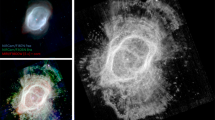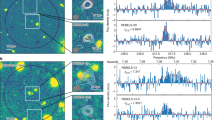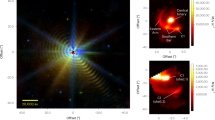Abstract
Low-mass stars are the most numerous stellar objects in the Universe. Before the James Webb Space Telescope (JWST), we had limited knowledge of how planetary systems around low-mass stars could form at subsolar metallicities. Here we present JWST observations of NGC 346, a star-forming region in the metal-poor Small Magellanic Cloud, revealing a substantial population of subsolar-mass young stellar objects (YSOs) with an infrared excess. We notice that continuing low-mass star formation is concentrated along dust filaments. We detected roughly 500 YSOs and pre-main-sequence (PMS) stars from more than 45,000 unique sources, using all four NIRCam wide filters with deep, high-resolution imaging. From these observations, we construct detailed near-infrared colour–magnitude diagrams with which preliminary categorizations of YSO classes are made. For the youngest, most deeply embedded objects, JWST/NIRCam is ten magnitudes more sensitive than Spitzer observations at comparable wavelengths, and reaches two magnitudes fainter than Hubble Space Telescope for more evolved PMS sources, corresponding to roughly 0.1 M⊙. The infrared sensitivity and resolution of JWST allows us to detect embedded low-mass star formation in an extragalactic environment. Furthermore, evidence of infrared excesses and accretion suggests that the dust required for rocky planet formation is present at metallicities as low as 0.2 Z⊙, which are akin to those in place at cosmic noon.
This is a preview of subscription content, access via your institution
Access options
Access Nature and 54 other Nature Portfolio journals
Get Nature+, our best-value online-access subscription
$29.99 / 30 days
cancel any time
Subscribe to this journal
Receive 12 digital issues and online access to articles
$119.00 per year
only $9.92 per issue
Buy this article
- Purchase on Springer Link
- Instant access to full article PDF
Prices may be subject to local taxes which are calculated during checkout


Similar content being viewed by others
Data availability
The data used in this study may be obtained from the Mikulski Archive for Space Telescopes (MAST, https://mast.stsci.edu/) and are associated with program no. 1227.
References
de Grijs, R. & Bono, G. Clustering of local group distances: publication bias or correlated measurements? III. The Small Magellanic Cloud. Astron. J. 149, 179 (2015).
Bouret, J. C. et al. Quantitative spectroscopy of O stars at low metallicity: O dwarfs in NGC 346. Astrophys. J. 595, 1182–1205 (2003).
Peimbert, M., Peimbert, A. & Ruiz, M. T. The chemical composition of the Small Magellanic Cloud H II Region NGC 346 and the primordial helium abundance. Astrophys. J. 541, 688–700 (2000).
Madau, P. & Dickinson, M. Cosmic star-formation history. Annu. Rev. Astron. Astrophys. 52, 415–486 (2014).
Dimaratos, A., Cormier, D., Bigiel, F. & Madden, S. C. Modeling the physical properties in the ISM of the low-metallicity galaxy NGC 4214. Astron. Astrophys. 580, A135 (2015).
Tchernyshyov, K. et al. Elemental depletions in the magellanic clouds and the evolution of depletions with metallicity. Astrophys. J. 811, 78 (2015).
Roman-Duval, J. et al. Dust and gas in the Magellanic Clouds from the HERITAGE Herschel Key Project. II. Gas-to-dust ratio variations across interstellar medium phases. Astrophys. J. 797, 86 (2014).
Johansen, A., Youdin, A. & Mac Low, M.-M. Particle clumping and planetesimal formation depend strongly on metallicity. Astrophys. J. Lett. 704, L75–L79 (2009).
Li, R. & Youdin, A. N. Thresholds for particle clumping by the streaming instability. Astrophys. J. 919, 107 (2021).
Ercolano, B. & Clarke, C. J. Metallicity, planet formation and disc lifetimes. Mon. Not. R. Astron. Soc. 402, 2735–2743 (2010).
Cignoni, M., Tosi, M., Sabbi, E., Nota, A. & Gallagher, J. S. History and modes of star formation in the most active region of the Small Magellanic Cloud, NGC 346. Astron. J. 141, 31 (2011).
Massey, P., Parker, J. W. & Garmany, C. D. The stellar content of NGC 346: a plethora of O stars in the SMC. Astron. J. 98, 1305 (1989).
Evans, C. J., Lennon, D. J., Smartt, S. J. & Trundle, C. The VLT-FLAMES survey of massive stars: observations centered on the Magellanic Cloud clusters NGC 330, NGC 346, NGC 2004, and the N11 region. Astron. Astrophys. 456, 623–638 (2006).
Dufton, P. L., Evans, C. J., Hunter, I., Lennon, D. J. & Schneider, F. R. N. A census of massive stars in NGC 346. Astron. Astrophys. 626, A50 (2019).
Nota, A. et al. Discovery of a population of pre-main-sequence stars in NGC 346 from Deep Hubble Space Telescope ACS images. Astrophys. J. Lett. 640, L29–L33 (2006).
Sabbi, E. et al. Past and present star formation in the SMC: NGC 346 and its neighborhood. Astron. J. 133, 44–57 (2007).
Hennekemper, E., Gouliermis, D. A., Henning, T., Brandner, W. & Dolphin, A. E. NGC 346 in the Small Magellanic Cloud. III. Recent star formation and stellar clustering properties in the Bright H II Region N66. Astrophys. J. 672, 914–929 (2008).
De Marchi, G., Panagia, N. & Sabbi, E. Clues to the star formation in NGC 346 across time and space. Astrophys. J. 740, 10 (2011).
Bolatto, A. D. et al. The Spitzer survey of the Small Magellanic Cloud: S3MC imaging and photometry in the mid- and far-infrared wave bands. Astrophys. J. 655, 212–232 (2007).
Gordon, K. D. et al. Surveying the agents of galaxy evolution in the tidally stripped, low metallicity Small Magellanic Cloud (SAGE-SMC). I. Overview. Astron. J. 142, 102 (2011).
Meixner, M. et al. The HERSCHEL inventory of the agents of galaxy evolution in the Magellanic Clouds, a Herschel Open Time Key program. Astron. J. 146, 62 (2013).
Simon, J. D. et al. The Spitzer survey of the Small Magellanic Cloud: discovery of embedded protostars in the H II Region NGC 346. Astrophys. J. 669, 327–336 (2007).
Sewiło, M. et al. Surveying the agents of galaxy evolution in the tidally stripped, low metallicity Small Magellanic Cloud (SAGE-SMC). III. Young Stellar Objects. Astrophys. J. 778, 15 (2013).
Seale, J. P. et al. Herschel Key Program Heritage: a far-infrared source catalog for the Magellanic Clouds. Astron. J. 148, 124 (2014).
Ruffle, P. M. E. et al. Spitzer infrared spectrograph point source classification in the Small Magellanic Cloud. Mon. Not. R. Astron. Soc. 451, 3504–3536 (2015).
Rubio, M., Barbá, R. H. & Kalari, V. M. Massive Young Stellar Objects in the N 66/NGC 346 region of the SMC. Astron. Astrophys. 615, A121 (2018).
Jones, O. C. et al. Near-infrared spectroscopy of embedded protostars in the massive metal-poor star forming region NGC 346. Mon. Not. R. Astron. Soc. 517, 1518–1537 (2022).
Hony, S. et al. Star formation rates from young-star counts and the structure of the ISM across the NGC 346/N66 complex in the SMC. Mon. Not. R. Astron. Soc. 448, 1847–1862 (2015).
Sabbi, E. et al. The Stellar Mass Distribution in the Giant Star Forming Region NGC 346. Astron. J. 135, 173–181 (2008).
Gouliermis, D. A., Hony, S. & Klessen, R. S. The complex distribution of recently formed stars. Bimodal stellar clustering in the star-forming region NGC 346. Mon. Not. R. Astron. Soc. 439, 3775–3789 (2014).
Rubio, M. et al. Multiwavelength observations of N 66 in the SMC: unveiling photodissociation interfaces and star formation. Astron. Astrophys. 359, 1139–1146 (2000).
Contursi, A. et al. Mid-infrared imaging and spectrophotometry of N 66 in the SMC with ISOCAM. Astron. Astrophys. 362, 310–324 (2000).
Neelamkodan, N. et al. ALMA reveals a cloud-cloud collision that triggers star formation in the Small Magellanic Cloud. Astrophys. J. Lett. 908, L43 (2021).
Sabbi, E. et al. The internal proper motion kinematics of NGC 346: past formation and future evolution. Astrophys. J. 936, 135 (2022).
Zeidler, P., Sabbi, E. & Nota, A. The internal line-of-sight kinematics of NGC 346: the rotation of the core region. Astrophys. J. 936, 136 (2022).
Rieke, M. J., Kelly, D. & Horner, S. Overview of James Webb Space Telescope and NIRCam’s role. In Proc. Cryogenic Optical Systems and Instruments XI, Vol. 5904 (eds Heaney, J. B. & Burriesci, L. G.) 1–8 (SPIE, 2005).
Bica, E. L. D. & Schmitt, H. R. A revised and extended catalog of Magellanic System Clusters, associations, and emission nebulae. I. Small Magellanic Cloud and bridge. Astrophys. J. Suppl. Ser. 101, 41 (1995).
Rodríguez, M. J. et al. PHANGS-JWST first results: dust-embedded star clusters in NGC 7496 selected via 3.3 μm PAH emission. Astrophys. J. Lett. 944, L26 (2023).
Dale, D. A. et al. PHANGS-JWST first results: the influence of stellar clusters on polycyclic aromatic hydrocarbons in nearby galaxies. Astrophys. J. Lett. 944, L23 (2023).
Sandstrom, K. et al. PHANGS-JWST first results: mapping the 3.3 μm polycyclic aromatic hydrocarbon vibrational band in nearby galaxies with NIRCam medium bands. Astrophys. J. Lett. 944, L7 (2023).
Lada, C. J. Peimbert, M. & Jugaku, J. (eds) in Star Forming Regions Vol. 115, 1–17 (IAU, 1987).
Robitaille, T. P., Whitney, B. A., Indebetouw, R., Wood, K. & Denzmore, P. Interpreting spectral energy distributions from Young Stellar Objects. I. A grid of 200,000 YSO model SEDs. Astrophys. J. Suppl. Ser. 167, 256–285 (2006).
Whitney, B. A. et al. Spitzer Sage survey of the Large Magellanic Cloud. III. Star formation and ̃1000 new candidate Young Stellar Objects. Astron. J. 136, 18–43 (2008).
Gordon, K. D., Clayton, G. C., Misselt, K. A., Landolt, A. U. & Wolff, M. J. A quantitative comparison of the Small Magellanic Cloud, Large Magellanic Cloud, and Milky Way ultraviolet to near-infrared extinction curves. Astrophys. J. 594, 279–293 (2003).
De Marchi, G. et al. Star formation in 30 Doradus. Astrophys. J. 739, 27 (2011).
Jones, O. C., Meixner, M., Justtanont, K. & Glasse, A. Probing the dusty stellar populations of the local volume galaxies with JWST/MIRI. Astrophys. J. 841, 15 (2017).
De Marchi, G. et al. Photometric determination of the mass accretion rates of pre-main-sequence stars. II. NGC 346 in the Small Magellanic Cloud. Astrophys. J. 740, 11 (2011).
Vázquez-Semadeni, E., Palau, A., Ballesteros-Paredes, J., Gómez, G. C. & Zamora-Avilés, M. Global hierarchical collapse in molecular clouds. Towards a comprehensive scenario. Mon. Not. R. Astron. Soc. 490, 3061–3097 (2019).
Willott, C. image1overf. Github https://github.com/chriswillott/jwst (2022).
Gordon, K. D. et al. The James Webb Space Telescope absolute flux calibration. I. Program design and calibrator stars. Astron. J. 163, 267 (2022).
Boyer, M. L. et al. The JWST resolved stellar populations early release science program. I. NIRCam flux calibration. Res. Notes Am. Astron. Soc. 6, 191 (2022).
Nally, C. & Jones, O. starbug2. GitHub https://github.com/conornally/starbug2 (2022).
Bradley, L. et al. astropy/photutils: 1.0.0. Zenodo https://doi.org/10.5281/zenodo.4044744 (2020).
Rieke, G. H. et al. The Mid-Infrared Instrument for the James Webb Space Telescope, I: introduction. Publ. Astron. Soc. Pac. 127, 584 (2015).
Cardelli, J. A., Clayton, G. C. & Mathis, J. S. The relationship between infrared, optical, and ultraviolet extinction. Astrophys. J. 345, 245–256 (1989).
Astropy Collaboration et al. Astropy: a community Python package for astronomy. Astron. Astrophys. 558, A33 (2013).
Taylor, M. B., Shopbell, P., Britton, M. & Ebert, R. in Astronomical Data Analysis Software and Systems XIV Vol. 347 (eds Shopbell, P. et al.) (ASPC, 2005).
Acknowledgements
This work is based on observations made with the NASA/ESA/CSA JWST. The data were obtained from the Mikulski Archive for Space Telescopes at the Space Telescope Science Institute, which is operated by the Association of Universities for Research in Astronomy, Inc., under NASA contract no. NAS 5-03127 for JWST. These observations are associated with program no. 1227. O.C.J. acknowledges support from a Science and Technology Facilities Council Webb fellowship. K.F. acknowledges support through the ESA Research Fellowship. M.M. acknowledges support through a NASA/JWST grant no. 80NSSC22K0025. M.M., N.H. and L.L. acknowledge support from the National Science Foundation through grant no. 2054178. L.E.U.C. was supported by an appointment to the NASA Postdoctoral Program at the NASA Ames Research Center, administered by Oak Ridge Associated Universities under contract with NASA. O.N. acknowledges support from STScI Director’s Discretionary Fund.
Author information
Authors and Affiliations
Contributions
O.C.J. led the analysis and is the science lead of the NGC 346 Team. C.N. produced the photometric catalogues. N.H. and L.L. reprocessed the NIRCam data. K.F. and C.R. assisted in the photometry. M.R., G.d.M. and E.S. provided advice on NIRCam data processing and the analysis on comparison to HST data. L.E.U.C. produced images on NGC 346. A.S.H., M.M. and K.P. helped optimize the observations. All authors contributed to observation planning and/or scientific interpretation.
Corresponding author
Ethics declarations
Competing interests
The authors declare no competing interests.
Peer review
Peer review information
Nature Astronomy thanks the anonymous reviewers for their contribution to the peer review of this work.
Additional information
Publisher’s note Springer Nature remains neutral with regard to jurisdictional claims in published maps and institutional affiliations.
Rights and permissions
Springer Nature or its licensor (e.g. a society or other partner) holds exclusive rights to this article under a publishing agreement with the author(s) or other rightsholder(s); author self-archiving of the accepted manuscript version of this article is solely governed by the terms of such publishing agreement and applicable law.
About this article
Cite this article
Jones, O.C., Nally, C., Habel, N. et al. JWST/NIRCam detections of dusty subsolar-mass young stellar objects in the Small Magellanic Cloud. Nat Astron 7, 694–701 (2023). https://doi.org/10.1038/s41550-023-01945-7
Received:
Accepted:
Published:
Issue Date:
DOI: https://doi.org/10.1038/s41550-023-01945-7



